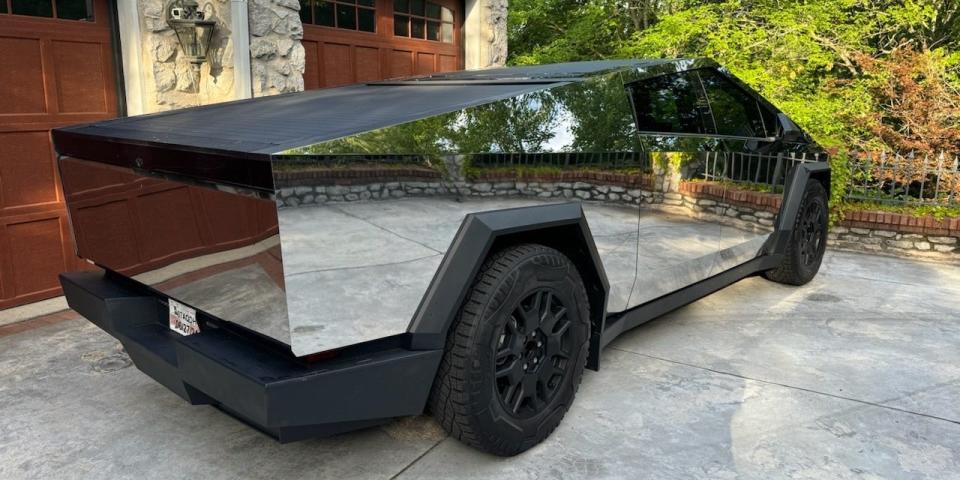Polishing a Cybertruck might not be the safest idea, but it's not illegal, traffic experts say

A Tesla Cybertruck owner went viral for polishing his vehicle to have a mirrorlike finish.
Some social-media users raised concerns that the customization could present road-safety hazards.
Traffic experts told BI that it might not be safe but there are no regulations around it.
Having a Cybertruck with a mirrored body may not be the safest idea, but it's not illegal, highway-safety experts and a traffic-court attorney told Business Insider.
In May, Tyson Garvin went viral on social media for polishing his Tesla Cybertruck to have a mirrorlike exterior.
Garvin told BI he thought the polishing job was not only an aesthetic improvement but also a practical upgrade. He said the new look helped with the common issue of fingerprint stains on the vehicle's stainless-steel exterior.
But is it safe?
Some social-media users reacting to Garvin's customization job raised concerns that the truck could be a road-safety hazard if its exterior reflected headlights back at drivers — and if it blended in with its environment on the road as well as it appeared to in photos.

Garvin told BI he had similar concerns about drivers' headlights bouncing off the truck's tailgate when driving at night. He said that during a road test he conducted with his wife, the tailgate only reflected the road because it was slightly slanted downward.
Experts told BI there isn't much literature on whether reflective car exteriors are more dangerous on the road.
"Reflective glare may pose the same problem for other drivers as headlight glare, but I am not aware of any research documenting whether this leads to or is associated with increased crash risk," David Zuby, the chief research officer for the Insurance Institute for Highway Safety, told BI in an email.
Johnathon Ehsani, a research director at Johns Hopkins Center for Injury Research and Policy, told BI he wasn't aware of studies that addressed whether a vehicle's exterior color affected safety.
However, Ehsani said there are two possible "mechanisms" that could make a reflective Cybertruck a road risk.
The first was similar to the concerns raised online: It's possible that the reflected glare from the vehicle could temporarily blind other drivers, Ehsani said, adding that he would have to see the vehicle in person to make a more certain conclusion.
Garvin told BI that the Cybertruck's shape causes sunlight to reflect onto the ground rather than toward other drivers.

Ehsani said that the more likely scenario for road risks is not unique to the reflective Cybertruck.
"The far more plausible case is a crash mechanism that is far more common, that people crash from every single day," he said, "and that's that it might attract attention because it's such an unusual-looking vehicle."
Ehsani coauthored a study published in the Journal of Adolescent Health in 2014 that documented the safety risks posed by distracted drivers. His research found that drivers are 3.8 times more likely to crash if they divert their attention from the road for more than two seconds.
This issue, of course, is not limited to unusual-looking vehicles, Ehsani said.
"It's not that different to, for example, looking at a billboard for longer than you need to or even messing around with your entertainment console," he said.
'Asking to be pulled over'
A polished Cybertruck may attract legal scrutiny even if there are no laws against customizing a vehicle's exterior color.
Martin A. Kron, a longtime New York traffic-court attorney and former judge, told BI that he's never dealt with a legal issue regarding a car's paint job in his 38 years of practice.
But having a car with an outlandish color attracts the attention of everyone — including police officers, he said.
"Although there may not be a spelled-out legal prohibition against it, in the real world, if you're driving a customized car, you're asking to be pulled over," Kron said, adding that officers could pull the driver over and find other reasons to give a ticket.
Zuby told BI that a car's paint job likely has no impact on insurance rates.
He said insurers are mostly restricted to using driving history rather than "predictive assessments" to set rates.
"So, unless an insurer had somehow documented that shinier vehicles had higher losses than less shiny ones, it would be unlikely to affect premiums paid," Zubu said. "Plus, it's unclear how an insurer would know that an insured made the vehicle shiny after purchase."
That is unless your vehicle is featured in a global publication, of course.
Read the original article on Business Insider

 Yahoo Autos
Yahoo Autos 